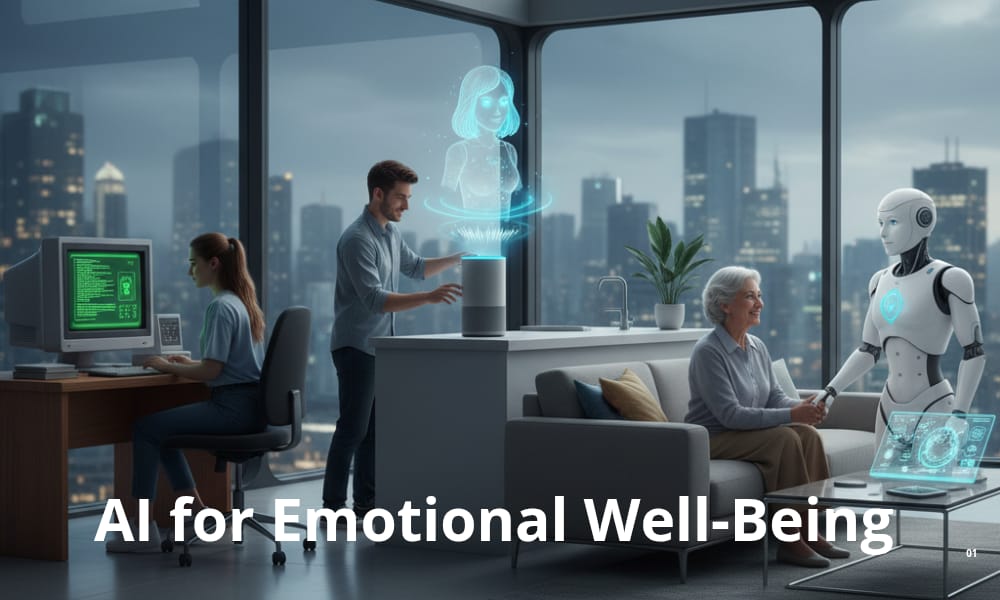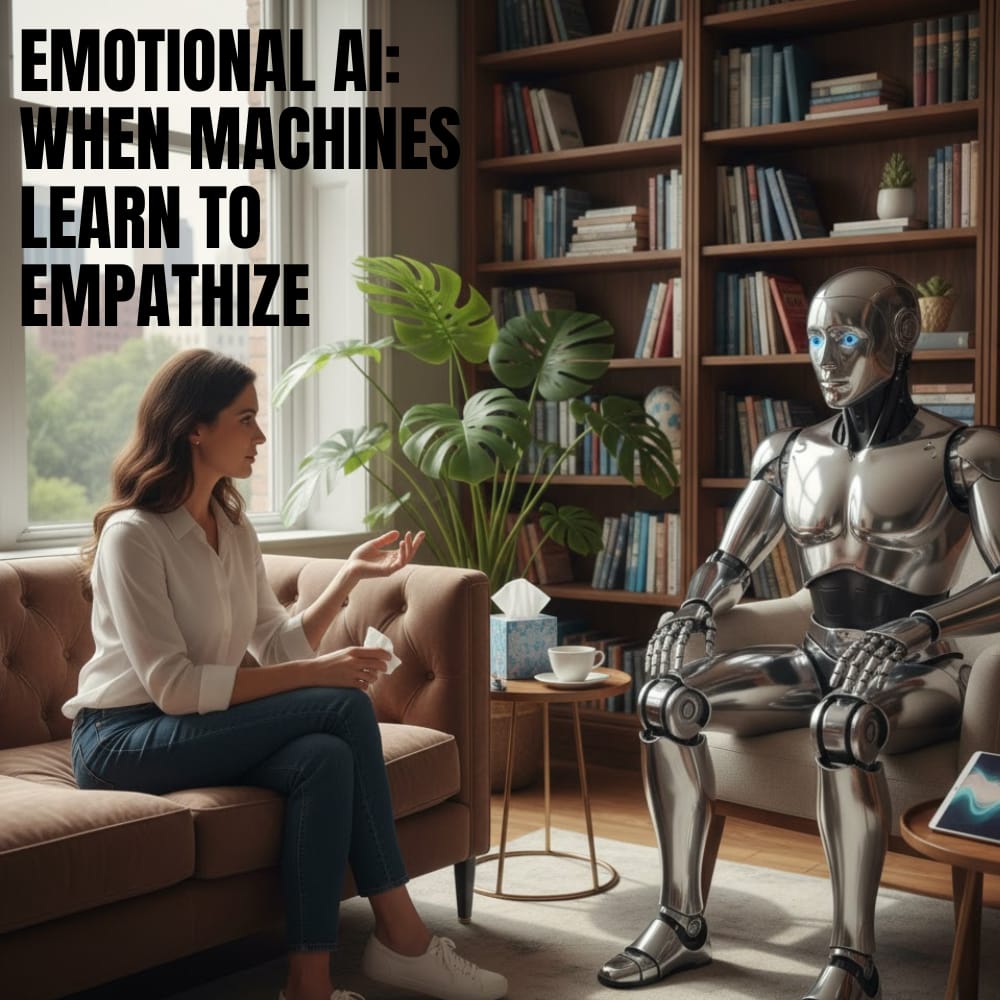AI for Emotional Well-Being: How Technology Is Learning to Feel
We’re taught to consider innovation as coherent, mechanical, and emotionless. But in 2025, something shocking is happening , our machines are beginning to get it how we feel.
From chatbots that sense pity in your tone to wellness apps that check your temperament some time recently giving counsel, Artificial Intelligence (AI) is gradually learning the dialect of feeling. This field is called affective computing and it’s discreetly reshaping how we approach mental wellbeing and emotional well-being.

The Thought Behind emotional AI
Emotional AI is planned to recognize, translate, and react to human emotions.
It works by analyzing prompts like:
Facial expressions
Voice tone
Word choice and sentence structure
Heart rate or breathing designs (through wearables)
The thought isn’t to supplant human sympathy, but to expand it. Imagine a virtual advisor that knows when you’re on edge indeed if you can’t say it out loud. Or a smartwatch that identifies stretch some time recently you deliberately feel it and prompts you to take a break.
That’s not sci-fi any longer. It’s as of now happening.
From Chatbots to Companions: The Rise of Passionate Tech
When early chatbots like Siri or Alexa arrived, they were absolutely useful , replying questions, setting alerts, and perusing the climate. But clients rapidly began talking to them as if they were human. That’s when tech companies realized something capable: individuals need sympathy, not fair efficiency.
Now, more current AI models can reflect feelings, offer consolation, and indeed alter their tone based on your mood.
Even mental wellbeing experts are starting to utilize passionate AI apparatuses to track or recognize emergency signs between treatment sessions.
Why Passionate AI Matters in a Focused World
Let’s confront it , we’re living in candidly requesting times.
Long work hours, data over-burden, online weight, and steady comparison have made stretch and burnout nearly widespread. Numerous individuals don’t look for assistance because of fear of disgrace, time imperatives, or cost.
This is where emotional AI can make a difference.
It offers:
24/7 support, you can converse with it anytime.
Privacy , no fear of judgment.
Accessibility , it’s cheaper (or free) and accessible anywhere.
For millions who can’t get treatment or mental wellbeing care, indeed a little virtual interaction that “understands” can feel like alleviation.
How Emotional AI Works Behind the Scenes
So, how does a machine “know” when you’re sad?
It’s all almost information and design recognition.
- Facial Examination: Cameras distinguish micro-expressions , minor muscle developments we can’t control, to sense feelings like fear, bliss, or anger.
- Speech Recognition: Algorithms study your voice tone, pitch, and recognise stress, weakness, or sadness.
- Content Investigation: Natural Language Processing (NLP) recognizes emotional words, sentences, and feelings in your messages.
- Biometric Input: Smartwatches or groups estimate heart rate changeability, sweat reaction, or rest quality to distinguish disposition changes.
All of these signals combine to make an emotional profile. Over time, AI learns your one of a kind designs , how you express push or joy , and reacts accordingly.
The Human Side of Emotional AI
What’s intriguing about this innovation is how human it makes our advanced encounters feel.
When your watch delicately proposes, “You appear stressed, how about a brief walk?” , it’s not imagining to care; it’s built to offer assistance you care for yourself.
The objective isn’t to make machines passionate but to make them candidly intelligent.
That subtle difference matters. Emotional insights implies mindfulness, understanding, and fitting reaction, qualities that can make innovation more steady and humane.
Imagine classrooms where AI mentors take note when a student is confused or disheartened. Or cars that identify driver weakness and caution them tenderly some time early before any accident. Or elderly care robots that sense loneliness and begin a conversation.
These applications appear to show that passionate AI isn’t just a mental wellbeing device , it’s a wellness companion that can improve security, instruction, and day by day life.
Ethical Questions: Can Compassion Be Coded?
Of course, when machines begin “reading” feelings, protection concerns aren’t far behind.
If a gadget can sense when you’re pitiful or on edge, who controls that data?
Can passionate data be utilized to control, showcase, or even discriminate?
These are genuine questions analysts and ethicists are wrestling with.
For instance, passionate AI in work environments might identify representative push levels , but ought a boss have to do that? What if companies utilize enthusiastic information for publicizing, focusing on powerless temperaments for profit?
To maintain a strategic distance from abuse, engineers must take after strict straightforwardness, assent, and data-protection rules. The passionate state of an individual ought to never end up as a product. Passionate AI ought to serve humankind, not misuse it.
Can AI Truly Get its Emotions?
Here’s the philosophical turn , can something without sentiments genuinely get its feelings?
AI can recognize designs of pity, but it doesn’t feel pitiful. It doesn’t know what depression feels like on a stormy day or the delight of hearing an ancient song.
So, whereas AI may show up compassionate, it’s eventually reflecting human behavior, not encountering it. That’s why specialists emphasize keeping the human touch at the center of passionate technology.
A chatbot can tune in, but it can’t supplant a friend’s embrace.

The Shining Side: Passionate AI as a Mental Wellbeing Ally
Despite its limits, emotional AI has as of now begun sparing lives.
Some suicide-prevention frameworks can distinguish self-harm chance in writings or voice tone and caution experts some time recently before the catastrophe strikes. Smartwatches presently track stress to offer assistance so that clients maintain a strategic distance from burnout.
And in rural regions or developing nations where mental wellbeing administrations are restricted, AI companions are filling pivotal holes. They may not be culminating advisors, but they’re great audience members, and that’s something innovation once in a while advertised before.
The other stage will likely combine AI + human advisors, making half breed care frameworks where innovation handles checking and early discovery, whereas people center on compassion and healing.
Looking Ahead: The Enthusiastic Future of Tech
In the next few years, passionate AI will end up as common as GPS , built discreetly into everything we use.
Imagine:
Smart homes altering lighting and music based on your mood.
Wearables advertising guided breathing when stress peaks.
Customized frameworks recognizing disappointment and connecting you to a human instantly.
The future isn’t about making robots cry, it’s about making innovation compassionate enough to take note when we do.
As emotional AI advances, it might offer assistance to help us rediscover something we’ve misplaced in our quick, computerized lives , the significance of abating down, feeling enough, and caring for our possessed mental space.
Conclusion
Conclusion
AI for mental well-being is one of the most intriguing wildernesses of innovation today.
It appears that AI doesn’t mean faster or smarter, some of the time it implies kinder.
While passionate AI will never supplant human sympathy, it can offer assistance to us to be more mindful of our feelings and more proactive about caring for them.
It’s not about machines feeling for us, it’s about machines making a difference in how we feel more human.
And perhaps that’s the most advanced innovation of all.








